Navigating Terahertz Communication: The Crucial Role of IP Management in Telecom Advancements
Terahertz (THz) technology is emerging as a transformative force in the telecom sector, offering unprecedented data rates, reduced latency, and enhanced spatial resolution. Operating within the 0.1 THz to 10 THz range, THz communication has the potential to dramatically improve mobile networks, advanced sensing applications, and more. However, the innovation and deployment of THz communication technology heavily rely on robust intellectual property (IP) protection and management. IP management plays a crucial role in navigating the complexities of deploying THz communication, ensuring that innovations are protected and leveraged effectively.
This article explores the multifaceted world of THz communication, focusing on its potential impact on the telecom industry. It also addresses implementation challenges, innovative solutions, and the intellectual property landscape, highlighting key patent trends and contributors.
Table of Contents
Understanding Terahertz Communication
Terahertz (THz) communication utilizes electromagnetic waves in the 0.1 to 10 THz range, offering high data rates and low latency for future 6G networks and beyond. Moreover, this cutting-edge technology leverages advancements in semiconductor materials, antenna design, and digital signal processing, offering an extensive bandwidth of up to 100 GHz—far exceeding the capabilities of millimeter wave (mmWave) technology.
The data transmission process in THz communication involves several sophisticated steps: framing, modulation, pulse-shaping, and digital-to-analog conversion at the transmitter. Subsequently, at the receiver, channel estimation, phase noise estimation, decoding, and demodulation are performed. These processes collectively enable ultrafast wireless connectivity, high-speed data rates, and low latency.
Effective IP management is crucial for the successful integration of THz technology into existing telecom infrastructures. Robust IP management frameworks ensure that innovations are protected and can be seamlessly incorporated, thereby enhancing overall network performance and reliability. By navigating the complexities of intellectual property, these frameworks play a vital role in the deployment and advancement of THz communication technology.
Significance of Terahertz Communication in Telecom
The potential benefits of THz communication in the telecom industry are immense. The short wavelength of THz signals, ranging from 30 µm to 3 mm, combined with the broad bandwidth of the THz band, provides opportunities for high spatial resolution, enabling applications such as high-precision imaging, mapping, and positioning. THz communication offers high-speed data transmission and low latency. Additionally, the small wavelength allows for the integration of many antennas into transceivers, forming ultra-massive multiple-input multiple-output (UM-MIMO) antennas within a compact area.
Furthermore, THz waves are non-ionizing, making them valuable for applications in sensing, imaging, airport security, and more. Their directional nature and the elimination of spectrum scarcity typical of sub-6GHz bands add to their appeal. However, THz communication may require specialized hardware components due to its unique characteristics and capabilities.
Moreover, by fostering innovation and protecting proprietary technologies, robust IP management frameworks play a pivotal role in the successful implementation and optimization of THz communication systems.
Key Applications of Terahertz Communication
Terahertz (THz) communication is revolutionizing various industries such as telecom, food, automotive, pharmaceuticals, ceramics, medicine, and security. THz waves have the capability to penetrate many materials, making them valuable for security applications in airports and border control. Additionally, THz waves can generate highly directional beams through miniature antenna arrays, which enhance their security-related utility in military operations. Moreover, THz waves can serve for environmental monitoring and control, including identifying pollutants and hazardous substances present in the atmosphere.
The introduction of Terahertz (THz) communication is transforming various industries, notably the telecom sector. Consequently, this section will delve into the various ways THz communication is enhancing the telecom industry.
6G Technology
6G technology will make significant advancements over 5G, with expected speeds reaching up to 206.25 Gbps, a substantial leap from the 10 Gbps speed of 5G. Operating on higher frequency bands from 30 to 300 GHz mm waves and utilizing up to 3000 GHz radiation, 6G is in its early stages of standard development. Organizations like the International Telecommunication Union (ITU) and the 3rd Generation Partnership Project (3GPP) are actively defining standards for 6G. The architecture of 6G addresses the limitations of 5G by incorporating components such as AI, programmability, softwarization, and a service-based architecture. This architecture is designed to be flexible, allowing the integration of new end-user devices and access network topologies for dynamic functionality upgrades that surpass the capabilities of 5G.
Key Differences Between 5G and 6G Technologies
| Feature | 5G Technology | 6G Technology |
| AI Integration | Limited or no AI integration | AI as a service is crucial, determining specific functions to be activated. |
| Programmability | Limited programmability through software-defined networking (SDN) and network functions virtualization (NFV), offering a degree of flexibility and control over networks | High programmability integrated into the network architecture, enhancing flexibility and intelligence with the integration of AI technology. |
| Device and Network Topology | Supports certain types of devices and topologies like Enhanced Mobile Broadband (eMBB), uRLLC and mMTC, but with certain constraints of flexibility and are limited by the predefined network functions and network slicing. | Accommodates new types of devices and topologies. The “Network of Networks” in [HEX-D51] [ECR+21], considers the usage of technologies for supporting flexible topologies to increase the availability and reliability of the connection. |
| Network Service Layer | A cloud-based platform with limited micro-service architecture that exclusively supports edge computing, resulting in inflexibility. | The shift towards cloud and microservices extends from central cloud environments to the extreme edge due to the integration of AI technology. |
| Blockchain-based Platform | Integrating blockchain technology with 5G and mobile edge computing aims to reduce load and enhance efficiency yet may introduce scalability challenges and performance constraints over time. | Utilizing a blockchain-based platform in 6G enables semi-quantum technology access control, allowing QB-RAN to explore additional spectrum in high-frequency bands, thereby expanding the technology for a broader range of applications. |
The potential applications of THz band technology in the telecom industry are diverse and encompass a range of transformative uses. These applications may include but are not limited to ultrafast wireless local-area networks, intra-chip connectivity, kiosk downloads, server farm connectivity, wireless backhaul, access in small cell networks, interconnection among micro/nanoscale machines, as well as Enhanced Mobile Broadband, and various others.
Ultrafast Wireless Local-Area Networks
THz communication, with its ultra-fast wireless connectivity and terabits per second (Tbps) data rates, shows promise for a wide range of services and applications. The small wavelength of THz waves reduces antenna spacing, allowing for more antennas in system design. This leads to higher directional beams, reducing the risk of eavesdropping compared to mmWave technology. Researchers are exploring higher frequencies to overcome spectrum scarcity and data rate limitations, aiming for ultra-broadband wireless links capable of 100 GHz and beyond. THz communication has the potential to enhance the performance of wireless local-area networks by providing higher data rates and lower latencies than current systems and technologies.
Intra-chip Connectivity
THz communication is a promising technology for intra-chip connectivity, utilizing planar nano-antenna arrays for data transmission between chip components. Wireless Network-on-Chips (WNoCs) can benefit from THz waves, easing wired connection challenges. Efficient design of on-chip THz antennas is essential for communication, with various designs like zigzag or dipole operating at frequencies resonant with the THz band. Achieving energy expenditure of less than 1 picojoule per bit is crucial for enhancing THz communications, even in scenarios with high insertion loss. This technology enables high-speed and energy-efficient techniques for intra-chip connectivity.
Kiosk Downloads and Server Farm Connectivity
Kiosk Downloads
The concept of Kiosk Downloads involves the rapid transfer of large data volumes to users’ devices in public locations. By leveraging the Terahertz (THz) band, downloads at multi-gigabit or even terabit-per-second speeds become possible, empowering users to acquire 8K videos, games, or software applications within seconds. Beamforming methods are utilized to focus signal power directly towards the user’s device, effectively addressing the challenges posed by high path losses. Additionally, advanced modulation schemes are employed to achieve exceptional data rates while upholding signal integrity over THz frequencies.
Server Farm Connectivity
Server farms, often referred to as data centers, are facilities designed to store, process, and distribute substantial volumes of data efficiently. Employing THz communication in server farms can facilitate ultra-high-speed data transmission, thereby enhancing both the capacity and operational performance of these data storage structures. Nonetheless, the successful integration of THz communication in server farms demands significant digital signal processing (DSP) capabilities to manage ultra-broadband signals effectively.
Enhanced Mobile Broadband (eMBB)
THz communication offers a higher data rate and a more extensive broadband experience for mobile users. This advancement enables applications such as high-definition streaming, holographic displays, virtual reality, and augmented reality. With THz waves, Enhanced Mobile Broadband (eMBB) can achieve download speeds of up to 10 Gbps, surpassing the capabilities of 5G networks. Unlike 5G, 6G networks utilize cell-free smart surfaces at high frequencies to attain ultra-fast data rates. Beamforming and Relay technologies play a key role in expanding the coverage area for eMBB services using THz waves. Among different beamforming architectures, hybrid beamforming architectures (HBAs) are preferred in THz communication systems due to their lower hardware complexity. Additionally, THz communication can support numerous simultaneous connections, a critical feature for eMBB, especially in scenarios such as public events requiring high-speed internet access.
Terabit Wireless Backhaul
The deployment of fiber optic connections often proves time-consuming and expensive, sometimes hindered by property owner restrictions. However, Terahertz (THz) wireless links emerge as a promising substitute for fiber optics, offering high-speed connections without the associated setup and upkeep expenses. This facilitates enhanced flexibility in network design and communication. At present, remote and secluded users encounter inferior coverage and subpar service quality. By augmenting optical fibers, THz links can seamlessly extend connectivity to small cells within the core network, playing a crucial role in ensuring universal telecommunication services characterized by superior quality, low latency, and pervasive connectivity across all areas.
For these advancements, robust IP management is essential. It safeguards innovations and facilitates their integration into existing telecom infrastructures, driving innovation and supporting THz communication deployment.
Challenges in THz Communication and Proposed Solutions
Challenges
- Signal Weakening: Terahertz signals experience substantial weakening during transmission because of factors such as free-space losses, molecular absorption, and scattering effects.
- Antenna Design: Antennas designed to transmit and receive THz signals play a critical role in enabling efficient communication over short distances while minimizing loss, especially when implementing precise beamforming techniques.
- Network Integration: Incorporating Terahertz (THz) communication into current heterogeneous network structures requires a focus on key components such as spectral efficiency and ongoing research and development efforts.
Proposed Solutions
- Enhancing Precision in Channel Modelling: To enhance the precision of THz Communication channel modelling, one must aim to concentrate signal energy more efficiently, thereby minimizing path loss. Utilizing channel modelling to pinpoint molecular transmission windows with low absorption rates consequently reduces energy absorption by molecules.
- Optimizing Antenna Technology: Enhancing plasmonic and dielectric resonator antennas to achieve high efficiency with Ultra-Wideband (UWB) capability in the Terahertz (THz) band is essential to meet the extensive bandwidth needs of 6G communication, while optimizing hybrid beamforming algorithms to control directionality ensures link stability and enhances signal reception at the receiver.
- Seamless Network Integration: Moreover, to enhance compatibility between THz communication systems and current networks, it is essential to establish a seamless integration that facilitates the smooth transition and conversion between high-speed THz frequencies and lower frequency signals and bands. Optimize backhaul solutions with a blend of wired and wireless technology to deliver robust connections in densely populated networks and leverage UAV-assisted backhaul to support wireless links for small base stations operating at terahertz frequencies among other innovative solutions
The Role of Intellectual Property in THz Communication
IP management plays a crucial role in fostering innovation and ensuring competitive advantage in the development of THz communication technology. By protecting inventions and innovations, IP encourages investment in research and development, driving technological advancements.
Evolving IP Management in the THz Communication Landscape
The IP management landscape for THz communication is rapidly evolving, moreover, with a significant increase in patent filings over the past few years. Leading companies and research institutions are actively filing patents to protect their innovations, indicating growing interest and investment in this field.
Effective IP management is crucial as the number of patents submitted for Terahertz communication in telecom applications has skyrocketed. As a key enabling technology for 6G wireless communication, the priority of patents in Terahertz communication applications significantly increased from 2019 to 2022. This trend suggests a robust future for THz technologies in the telecom sector.
Note: Data from 2023 onwards is provisional, considering the 18-month window from the filing date to publication. Some patent applications filed in 2023 and 2024 may not yet be published.
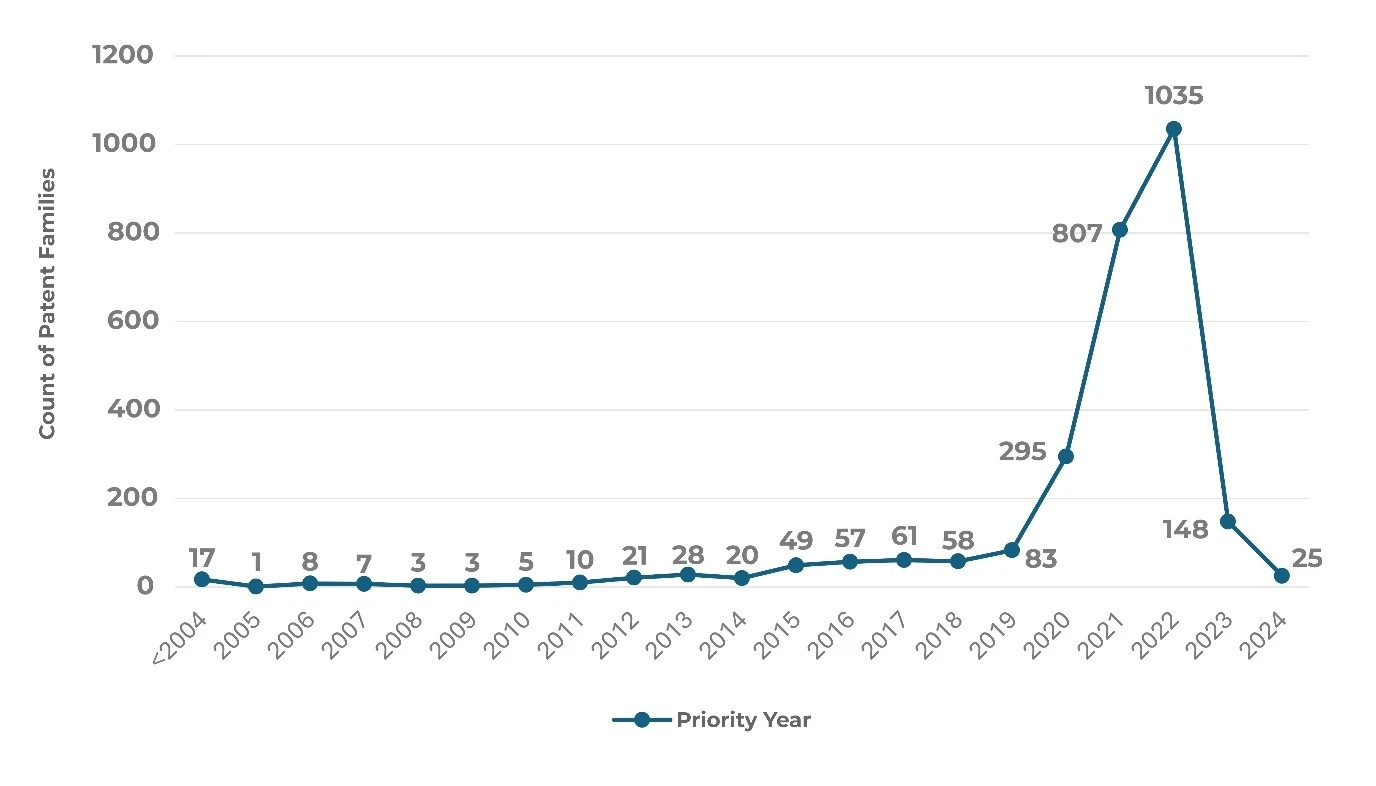
Figure 1: Patent Priority Trends in THz communication in the Telecom Sector
Top Patent Holders and Inventors
Leading companies like Samsung Electronics, LG Electronics, Vivo Mobile Communication, University of Electronic Science & Technology of China, and Huawei are highly active in the domain of THz communication in the telecom sector. Additionally, companies or universities like NIDEC WGR, 13th Research Institute of China Electronics Technology, Southeast University, Tsinghua University, and Beijing University of Posts & Telecommunications are also active in this domain.
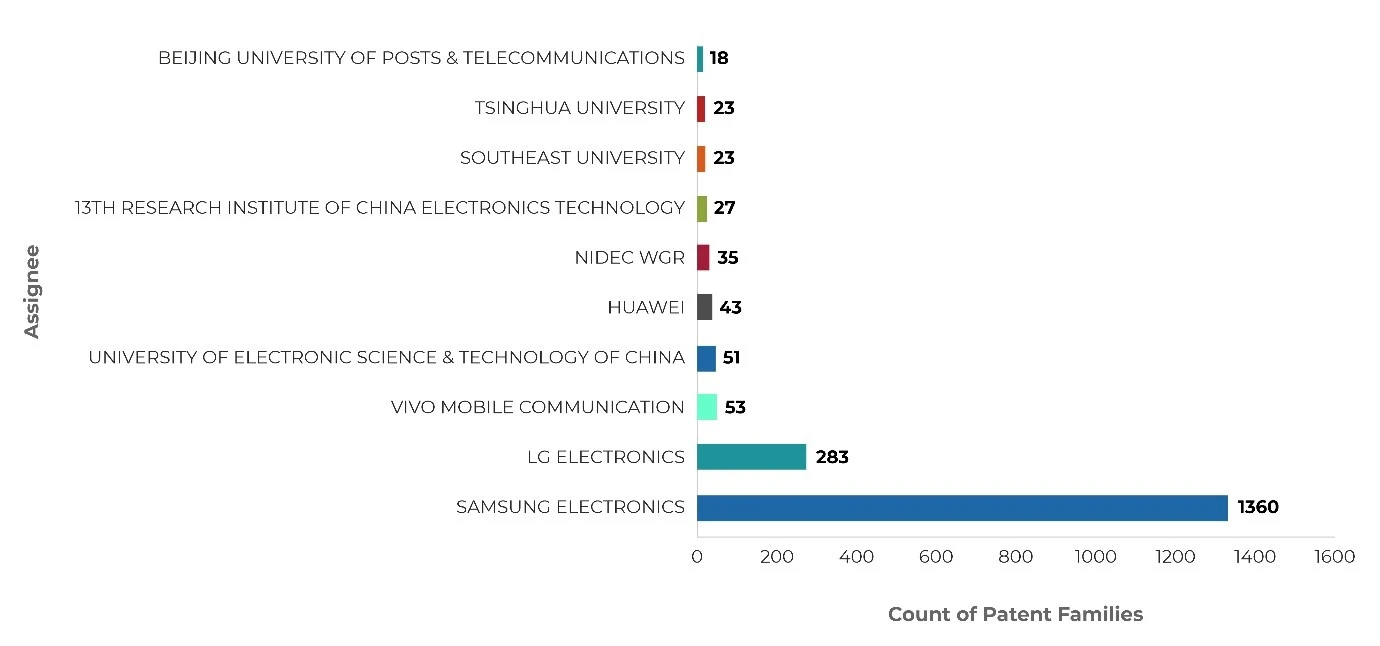
Figure 2: Top Assignee
Top Inventor in THz communication in the Telecom Sector
In the rapidly evolving field of THz communication within the telecom sector, several inventors have made significant contributions.
- Among them, KIM stands out as a leading figure, holding the maximum number of patent families in this domain.
- Other notable inventors include LEE, SUN FEIFEI, ONGGOSANUSI EKO, and KUMAR LALITH, who have also made substantial advancements in THz communication.
- Additionally, inventors such as WATFA MAHMOUD, RAHMAN MD SAIFUR, AGIWAL ANIL, PAPASAKELLARIOU ARISTIDES, and JI HYOUNGJU are actively contributing to this field.
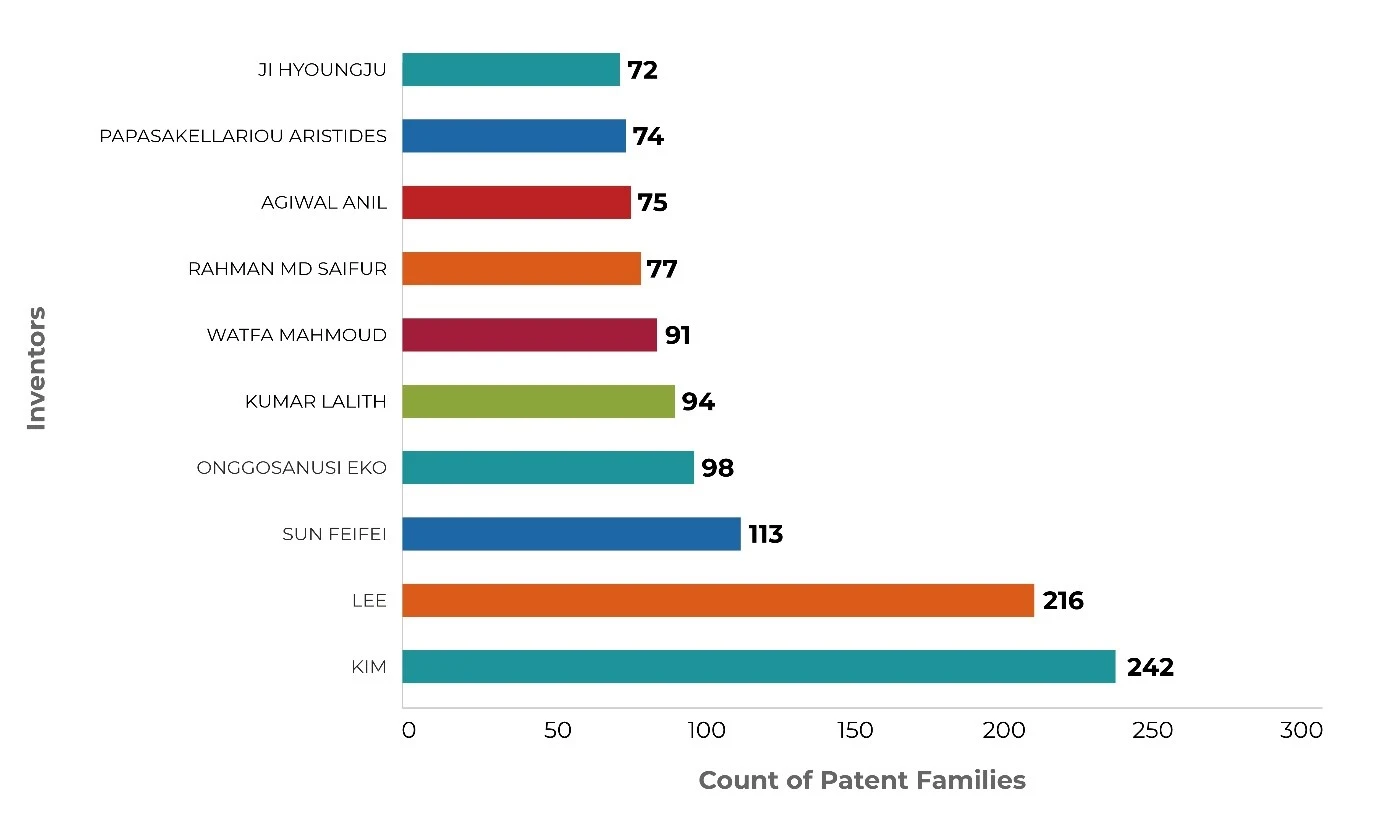
Figure 3: Top Inventors
Top Country of Origin
The country of origin refers to where the patent was first filed, indicating where the invention was developed. Specifically, each patent family has only one country of origin. The graph below illustrates the major countries of origin for relevant patent families in THz communication.
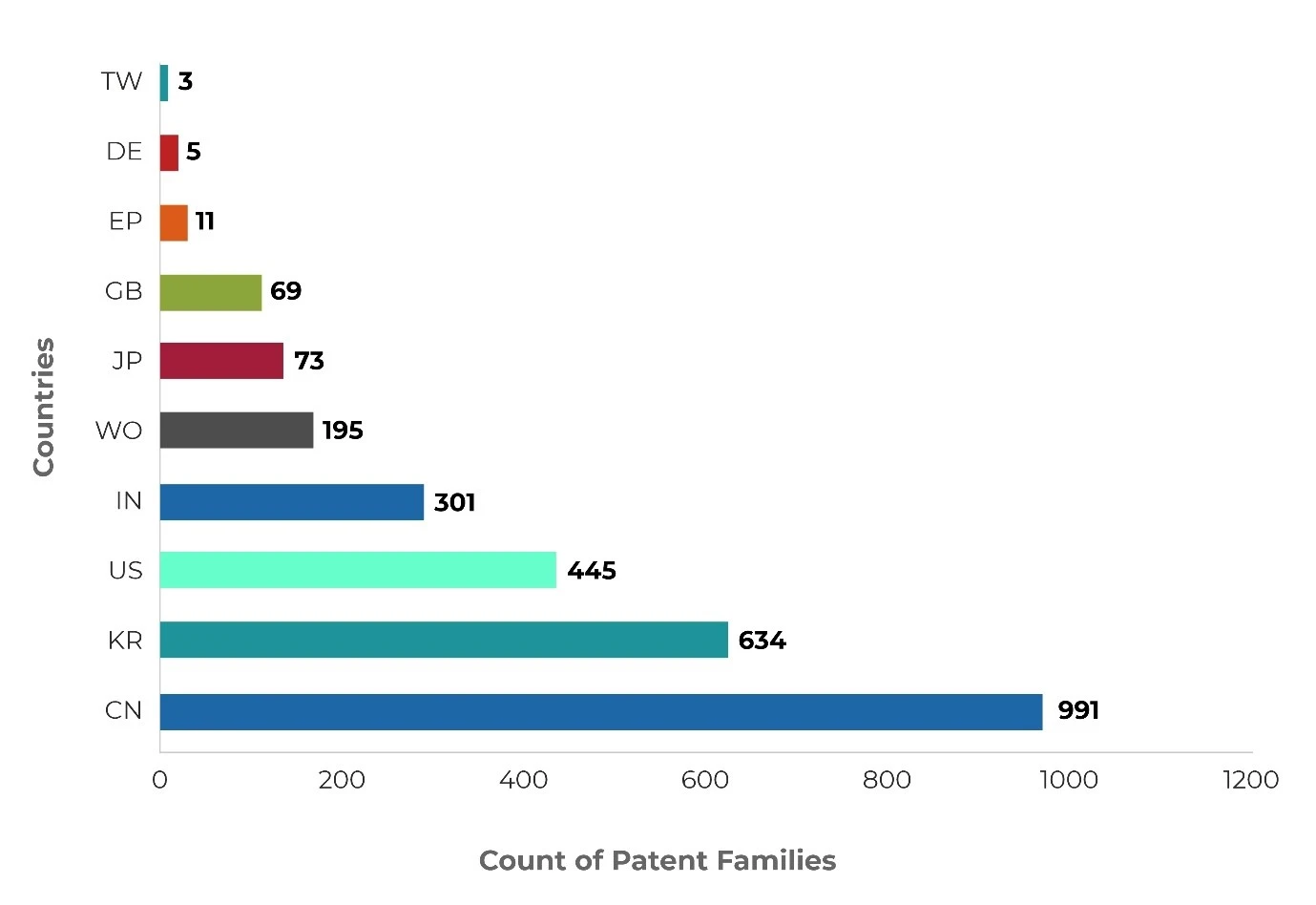
Figure 4: Country of Origin
As shown:
- The majority of patent applications were first filed in China (CN), with a significant number also originating from Korea (KR).
- Other notable countries include the United States (US), India (IN), Japan (JP), the United Kingdom (GB), Germany (DE), and Taiwan (TW).
- Some patents have also taken the PCT (Patent Cooperation Treaty) and EP (European Patent Convention) routes, which provide unified procedures to protect inventions across multiple designated states.
Top deposition of countries in THz communication in the Telecom Sector
Deposition countries refer to jurisdictions where patents are subsequently filed, highlighting the strategic global approach adopted by innovators to protect their intellectual property rights.
- The below graph represents all the family members filed in different jurisdictions. The count of patent references filed in US is more than those filed in PCT [Patent Cooperation Treaty] and China (CN), since a patent family may have a greater number of US members.
- Moreover, countries like Korea (KR), India (IN), United Kingdom (GB), Germany (DE), Canada (CA), Japan (JP), and Europe (EP) emerge as significant deposition destinations, underscoring the widespread geographical footprint of THz communication advancements in the Telecom Sector.
- This analysis underscores not only the technical prowess and innovative spirit driving THz communication advancements but also the strategic global vision of inventors in securing their technological breakthroughs across diverse international landscapes.
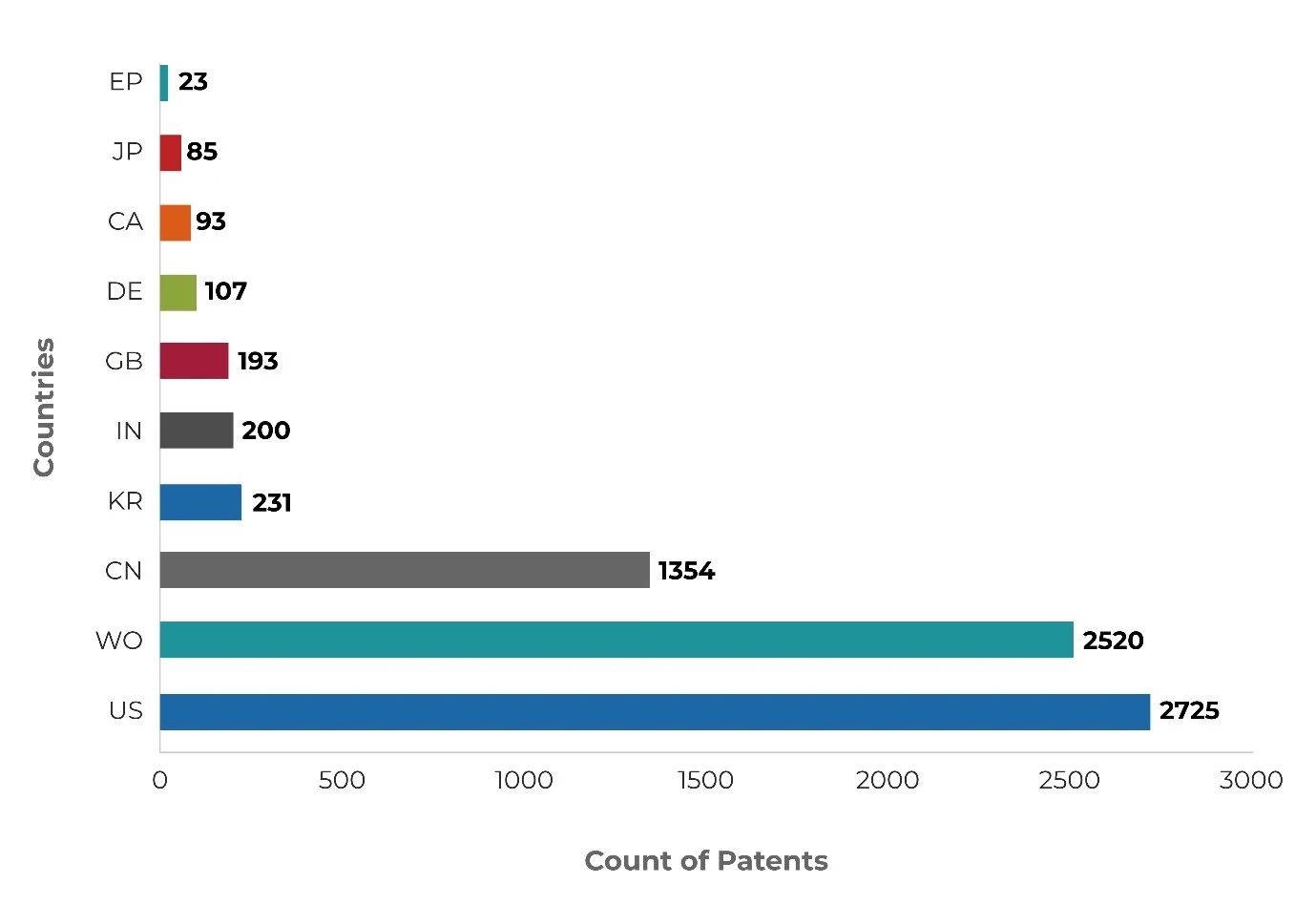
Figure 5: Top Deposition Country
Earliest Filing Trends of Assignees (2020-2024) in THz Communication within the Telecom Sector
The evolution of THz communication technology within the Telecom Sector is marked by significant patent filings across various years and by leading companies. The following chart illustrates the distribution of patent families filed annually by major assignees.
Year-wise Patent Filing Distribution
The chart below provides insights into the annual patent filing activities of key companies in the THz communication sector. Samsung Electronics emerges as a leader, consistently topping the charts with substantial filings in recent years, particularly in 2022 and 2023. LG Electronics also demonstrates robust filing activity, notably leading in 2021.
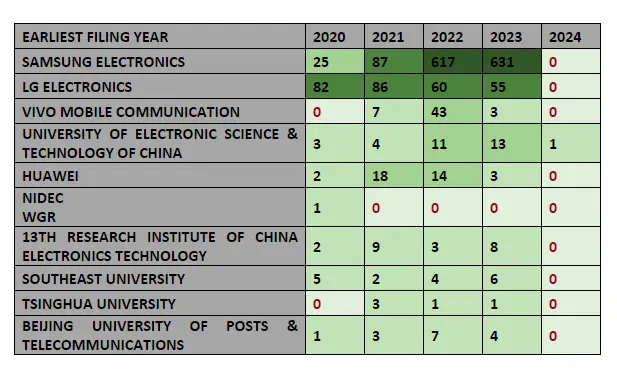
Figure 6: Earliest Filing Trend of Assignees
Major Assignees and Country of Origin in THz Communication within the Telecom Sector
In the global landscape of THz communication patents, the geographical distribution of filings reveals strategic insights into where innovation originates and seeks protection. Specifically, the chart below highlights the primary assignees and their corresponding earliest priority countries for patent filings.
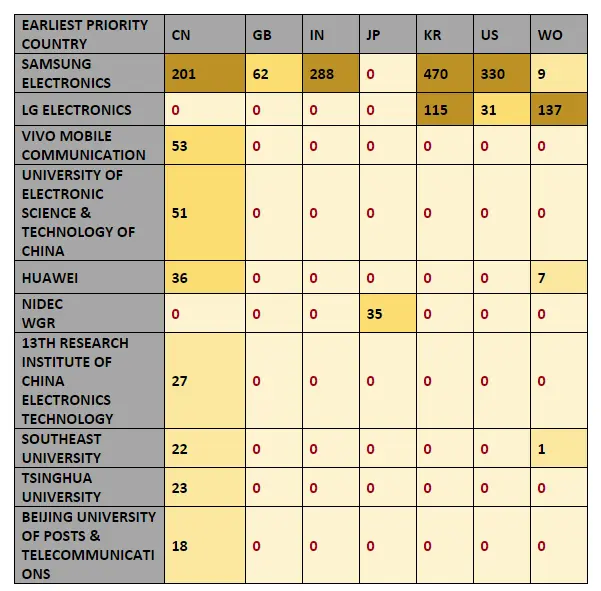
Figure 7: Major Assignees and Country of Origin
- Samsung Electronics is one of the top Korean companies that has done maximum patent filling in Korea (KR) with 470 filings, while also filing significantly in other jurisdictions.
- LG Electronics has done maximum patent filings primarily through the Patent Cooperation Treaty (PCT), reflecting a broad international strategy.
- Vivo Mobile Communication, University of Electronic Science & Technology of China, and Huawei concentrate their patent activities in China (CN), positioning themselves at the forefront of technological advancements in the region.
Top International Patent Classification (IPC) in THz communication in the Telecom Sector
The chart below shows the distribution of THz communication in the telecommunications domain patents by IPC classification. The main IPC classes cited are:
- H04B-007/06: ~125 patents
- H04L-005/00: ~86 patents
These classifications highlight the primary technological areas within the THz communication domain. The number of patents in each class is higher compared to total no. of patents in the portfolio, as one patent reference may cite more than one IPC Main or sub-class.
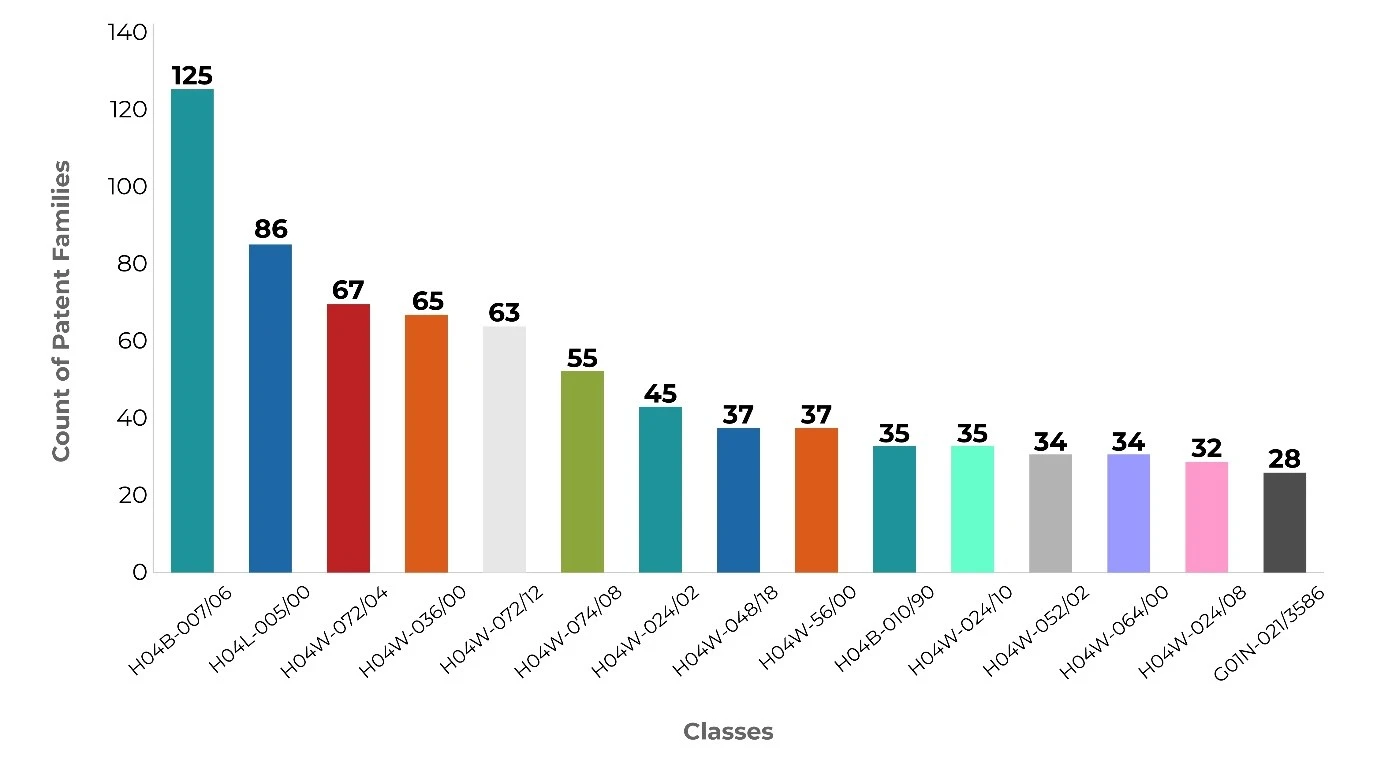
Figure 8: Top IPC Class in THz communication
Legal Status of Patent Families in THz Communication in the Telecom Sector
The legal status of patent families in the domain of THz communication in telecommunications is as follows:
- Granted Patents: Approximately 16%
- Pending Patents: Approximately 77%
Notably, Samsung Electronics holds 91 granted patent families and 1,269 pending patent families in the THz communication sector. LG Electronics and Vivo Mobile Communication hold 269 and 52 pending patents, respectively.
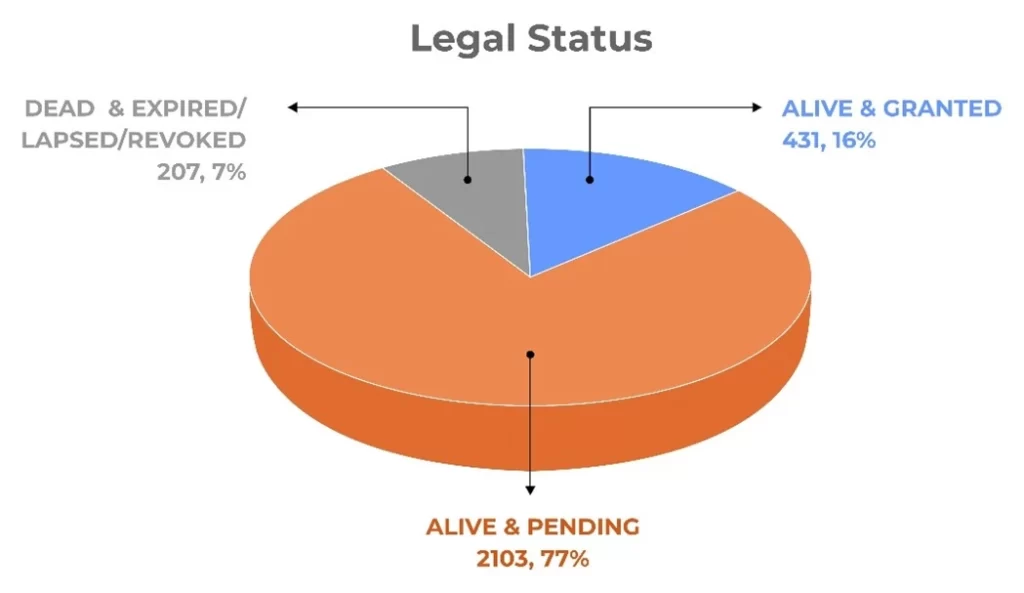
Figure 9: Legal Status of Patent Families in THz Communication
Top Terahertz Communication Startups
- TeraNovva: Established in 2022, is a technology-driven startup specializing in the development of a real-time ultra-broadband software-defined radio platform for terahertz communication. This innovative platform offers up to 10GHz bandwidth with speeds exceeding 60 Gbps. The technology is poised to revolutionize wireless 6G networks by providing cutting-edge networking solutions in the terahertz domain. Noteworthy applications of this platform include commercial applications like back-haul wireless links and mobile edge computing, as well as research applications for testing tailored routing solutions for terahertz networks. Key advantages of this platform include its cost-effective design and low-latency network performance, facilitating high-speed data transfers.
- Triseka: A recent startup, established in 2021, is currently working on creating an initial compact, high-power terahertz radiation source capable of generating coherent terahertz radiation. Furthermore, this technological advancement holds significance as it can be utilized in a wide array of real-time imaging applications. The breakthrough achieved by Triseka is pivotal for the terahertz communication sector as it greatly improves the functionality of imaging and scanning technologies, playing a critical role in the development of communication systems and industrial analysis. Triseka’s efforts are positively impacting the expanding domain of THz communication, which is positioned as the future of wireless networks, encompassing the realms of 6G technology and beyond.
- Spatialite Antenna Systems (SIA): Established in 2021, SIA specializes in designing and developing liquid crystal compositions tailored for wireless communications within the GHz and THz spectrum. Additionally, SIA focuses on metamaterial structures and advanced electronically steerable antennas (ESA) for applications in 5G technology and future wireless network generations.
Global Terahertz Technology Market
The Terahertz communication market in the telecommunications industry is rapidly expanding. Moreover, the market size for Terahertz technology was estimated at USD 0.6 billion in 2022 and is projected to reach USD 1.2 billion by 2027, with a forecasted CAGR of 14.7%. This growth is driven by the burgeoning telecommunication infrastructure and the critical role of the telecommunication sector in data translation and transfer.
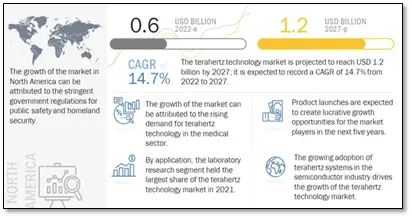
Figure 10: Global Terahertz Technology market
Conclusion
Terahertz communication stands poised as a crucial facilitator for cutting-edge 6G networks, revolutionizing wireless communication with its capability for ultra-high-speed data transmission. Furthermore, beyond enhancing 6G networks, its potential spans across diverse sectors including healthcare, security, and imaging. Continuous research and development efforts are actively addressing technical challenges, thereby paving the path for significant market expansion. Additionally, this technology holds the promise of achieving unparalleled levels of connectivity and advancing IP management strategies for THz communication.
How Sagacious IP Can Help
Sagacious IP offers comprehensive intellectual property (IP) services that can assist companies in navigating the complexities of THz communication technology. Moreover, our services include:
- Patent Landscaping and Analysis: Identifying trends, key players, and emerging opportunities in THz communication.
- Patent Filing and Prosecution: Assisting in drafting, filing, and prosecuting patents to protect your innovations.
- Technology Scouting: Identifying potential technology partners and collaborators to enhance your R&D efforts.
- IP Portfolio Management: Managing and optimizing your IP portfolio to align with your business strategy.
With our expertise, we can help you secure and leverage your IP assets to gain a competitive edge in the rapidly evolving THz communication landscape. Therefore, let Sagacious IP be your partner in innovation and growth.
– By: Shubham Kumar & Prem Kumar Morya (ICT Searching) and the Editorial Team
Having Queries? Contact Us Now!
"*" indicates required fields




